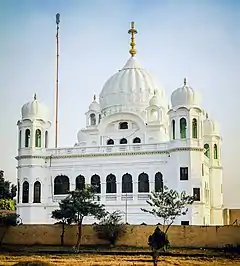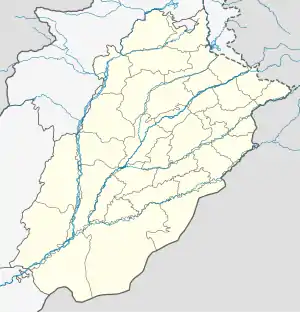Kartarpur
کرتار پور | |
|---|---|
 The Gurdwara Darbar Sahib Kartar Pur was built to commemorate the spot where Guru Nanak is said to have died. | |
 Kartarpur  Kartarpur | |
| Coordinates: 32°05′N 75°01′E / 32.08°N 75.01°E | |
| Country | |
| Province | |
| District | Narowal |
| Tehsil | Shakargarh |
| Elevation | 155 m (509 ft) |
| Time zone | UTC+5 (PST) |
| Website | kartarpur |
Kartarpur (Punjabi: کرتار پور (Shahmukhi), ਕਰਤਾਰਪੁਰ (Gurmukhi); Urdu: کرتارپور) is a town located, in the Shakargarh Tehsil, Narowal District in Punjab, Pakistan. Located on the right bank of the Ravi River, it is said to have been founded by the first guru of Sikhism, Guru Nanak, where he established the first Sikh commune.
Geography
Kartarpur is located at 32°5′13″N 75°1′0″E / 32.08694°N 75.01667°E. It is located in Narowal District, Punjab, Pakistan. It has an average elevation of 155 metres (511 feet).
History
The first guru of Sikhism, Guru Nanak, founded Kartarpur in 1504 AD on the right bank of the Ravi River. The name Kartarpur means "city of Creator or God", from Punjabi "ਕਰਤਾਰ" (Kartar) meaning 'Creator' or 'Lord of Creation' and "ਪੁਰ" (Pur) meaning 'City'. Here all people, irrespective of their religion or caste, lived together, representing the first 'Sikh commune'. After his travels for about 20 years, Guru Nanak settled in Kartarpur along with his family. Following his death in 1539, Hindus and Muslims both claimed him as their own, and raised mausoleums in his memory with a common wall between them. The changing course of the Ravi River eventually washed away the mausoleums. But Guru Nanak's son saved the urn containing his ashes and reburied it on the left bank of the river, where a new habitation was formed, representing the present day Dera Baba Nanak.[1][2][3][4] After Nanak's passing, the early Sikh community's headquarters was shifted from Kartarpur to the village of Khadur by his successor, Guru Angad.[5]
At the location Guru Nanak is believed to have died, the Gurdwara Kartarpur Sahib was built. It is considered to be the second holiest site for the Sikh religion.
During the 1947 partition of India, the region got divided across India and Pakistan. The Radcliffe Line awarded the Shakargarh tehsil on the right bank of the Ravi river, including Kartarpur, to Pakistan, and the Gurdaspur tehsil on the left bank of Ravi to India.[6]
Kartarpur Corridor
On 9 November 2019, Prime Minister Imran Khan inaugurated the opening of a cross-border Kartarpur Corridor allowing Indian Sikhs to visit Pakistan without a visa.[7] On the same day, the first Jatha (batch) of over 500 Indian pilgrims visited the shrine thanking Prime Minister Khan for "respecting the sentiments of India" towards the shrine across the border that marks the final resting place of Sikhism founder Guru Nanak Dev.[8][9]
Under the leadership of Akal Takht Jathedar Giani Harpreet Singh, the first Jatha traveled through the corridor into Pakistan to pay obeisance at Gurdwara Darbar Sahib Kartarpur[10] which included former Indian Prime Minister Manmohan Singh.[11] The delegation also included ex-PM's wife, Gursharan Kaur, Chief Minister of Punjab, Captain Amarinder Singh, Navjot Singh Sidhu, Sunny Deol, and 150 Indian parliamentarians.[12]
Demography
The population is primarily Punjabi. Majority of peoples belongs to Gurjars, Rajputs and Jats casts. After the Partition of Punjab in 1947, the minority Hindus and Sikhs migrated to India while many Muslim refugees from India settled down in Kartarpur.
See also
References
- ↑ Nesbitt, Eleanor M.; Kaur, Gopinder (May 1998), Guru Nanak, Bayeux Arts, p. 15, ISBN 978-1-896209-27-2
- ↑ Singh, Jagraj (2009), A Complete Guide to Sikhism, Unistar Books, p. 211, ISBN 978-81-7142-754-3
- ↑ Singha, H. S. (2000), The Encyclopedia of Sikhism, Hemkunt Press, p. 59, ISBN 978-81-7010-301-1
- ↑ "Guru Nanak Sahib". Sgpc.net. Archived from the original on 18 February 2012. Retrieved 10 February 2012.
- ↑ Singh, Pashaura (2021-04-03). "Ideological basis in the formation of the Shiromani Gurdwara Prabandhak Committee and the Shiromani Akali Dal: exploring the concept of Guru-Panth". Sikh Formations. 17 (1–2): 3–4. doi:10.1080/17448727.2021.1873656. ISSN 1744-8727. S2CID 234146387.
The second Guru, Angad (1504–1552), established a new Sikh center at his native village Khadur because Guru Nanak's sons made the legal claim as rightful heirs of their father's properties at Kartarpur. It confirmed an organizational principle – that the communal establishment at Kartarpur should not be considered a unique institution, but rather a model that could be cloned and imitated elsewhere. Similarly, the sons of Guru Angad inherited the establishment at Khadur, forcing his successor to move to Goindval ('City of Govind', an epithet of God) on the right bank of the river Beas.
- ↑ Yadav, V.; Sharma, H. (2015), "Disaster Management in Border Sensitive Area: Case Study of Amritsar District", in Huong Ha; R. Lalitha S. Fernando; Amir Mahmood (eds.), Strategic Disaster Risk Management in Asia, Springer, p. 216, ISBN 978-81-322-2373-3
- ↑ Siddiqui, Naveed (9 November 2019). "'This is the beginning': PM Imran inaugurates Kartarpur Corridor on historic day". Dawn.
- ↑ "Kartarpur corridor: PM Modi thanks PM Imran Khan during inauguration of the Integrated Check Post". gulfnews.com. Retrieved 17 November 2019.
- ↑ "Kartarpur Corridor opening a historic moment". Gulf News. Retrieved 11 November 2019.
- ↑ "Akal Takht chief to lead first jatha". Hindustan Times. 8 November 2019. Retrieved 10 November 2019.
- ↑ "Kartarpur corridor's opening to 'enormously improve' India-Pakistan ties: Manmohan Singh". Times of India. 9 November 2019.
- ↑ "Kartarpur corridor: India pilgrims in historic visit to Pakistan temple". BBC News. 9 November 2019.
External links
- www.etpb.gov.pk/kartarpur-corridor, Sri Kartarpur Sahib Corridor official website
- prakashpurb550.mha.gov.in, Indian website portal for registration
- More Information and Updates: kartarpur.com.pk
- Corridor of Light Photo Essay, India Today
- pictures: Gurdwara Darbar Sahib in Kartarpur, Geo TV, 28 November 2018.